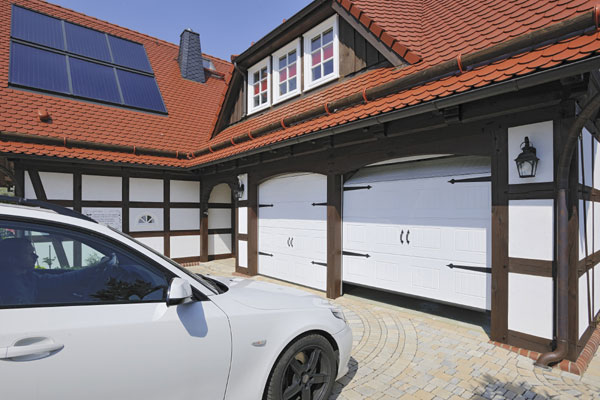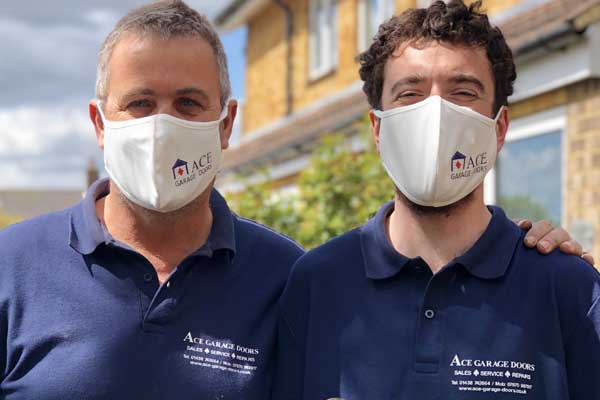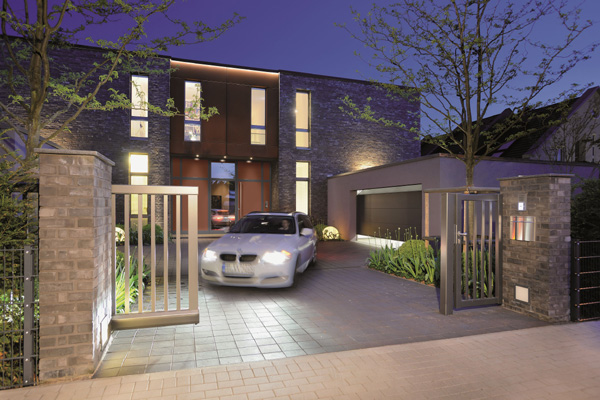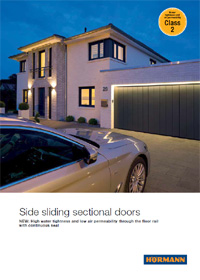Quality, Reliability & Great Value
Garage Doors Stevenage, Hertfordshire | Garage Door Repair Stevenage, Hertfordshire | Roller Shutter Garage Doors Stevenage, Hertfordshire
A new garage door for your Stevenage property will not only look great. It will keep your prized car safe from unwanted attention from ne'er-do-wells, as well as the damaging effects of prolonged exposure to the elements.
Not only will a new garage door achieve the above, it will also make your property in Stevenage more desirable should you be looking to sell your property. When you see some of our garage doors, you'll see why we are considered the number one garage door supplier and fitter in the Stevenage area and beyond.
Some interesting facts about Stevenage
Stevenage has quite a rich history and lies near the line of the Roman road from Verulamium to Baldock. Some Romano-British remains were discovered during the building of the New Town, and two thousand silver Roman coins was discovered in 1986 during new house building in the Chells Manor area. The most substantial evidence of activity from Roman times is Six Hills, six tumuli by the side of the old Great North Road. It is thought that the hills were the burial places of a local family. A good deal of folklore surrounds the famed Stevenage hills; some of them are quite fantastical too!
Local legend suggest that they were the work of the Devil himself, who, sitting one day looking down on the Great North Road, began to amuse himself by heaving clods of earth at the passers-by. He missed six times and in a temper threw a seventh clod over his shoulder, hitting the spire of Graveley church and knocking it askew. The spire is still crooked to this day. The holes in Whomerley Wood show where the Devil dug out his missiles, and the six failed shots lie in a line alongside the road and form the Six Hills.
Facts over folklore about the Stevenage mounds
The Six Hills in Stevenage are almost certainly Roman burial mounds, dating from about 100 A.D., and probably mark the cremated remains of a very wealthy local family. The ashes would have been placed in a container along with objects for use in the next world. This practice has been around since the Pharaohs of ancient Egypt, who not only had their jewels and furniture buried with them, they would take things a step further and have their pets and servants join them in the afterlife too.
No recent scientific archaeological excavation has been carried out on the Stevenage Hills, but they have all been dug into in the past. These early investigations found only "...a few pieces of wood and a piece of iron..." which were dismissed at the time, but probably were the remains of the original burials. Other reports of damage include the farmer who was carting soil away from the Hills in 1750, and an attempted widening of the Great North Road in about 1820. Over the years, the Hills have all lost over 4 feet in height.
The grass around the burial mounds is of considerable age and is considered an important part of local Stevenage ecology. It includes species such as bird's-foot trefoil, mouse-ear hawkweed, harebells, whitlow grass, and slender clover, which are not found in the more modern grasslands nearby.
Pre-Conquest Stevenage history
Stevenage lies near the line of the Roman road from Verulamium to Baldock. Some Romano-British remains were discovered during the building of the New Town, and a hoard of 2,000 silver Roman coins was discovered during house building in the Chells Manor area in 1986. Other artefacts included a dodecahedron toy, fragments of amphorae for imported wine, bone hairpins, and samian ware pottery associated with very high status families. Archaeological excavations have confirmed the existence of a small Roman farmstead, a malting kiln and a Celtic round house in the Chells area, and a cemetery containing twenty five cremations. The most substantial evidence of activity from Roman times is the Six Hills, mentioned above.
The first Saxon camp, a little to the east of the Roman sites, was in a clearing in the woods where the church, the manor house and the first village were later built. Settlements also sprang up in Chells, Broadwater and Shephall. Before the New Town of Stevenage was established, Shephall was a separate parish, and Broadwater was split between the parishes of Shephall and Knebworth.
During the 9th and 10th centuries AD, the Saxon village in Stevenage faced frequent attacks from Viking raiders. Stevenage was on the border of the Danelaw. A Viking spearhead was discovered by archaeologists at nearby Ardeley.
The Danelaw was the part of England between the early tenth century and the Norman Conquest under Anglo-Saxon rule in which Danish laws applied. The Danelaw originated in the conquest and occupation of large parts of eastern and northern England by Danish Vikings in the late ninth century. The term applies to the areas in which English kings allowed the Danes to keep their own laws following the tenth-century English conquest in return for the Danish settlers' loyalty to the English crown. "Danelaw" is first recorded in the early 11th century as Dena lage.
Middle Ages in Stevenage
According to the Domesday Book, in 1086 the Lord of the Manor was the Abbot of Westminster Abbey. The settlement had moved down to the Great North Road. In 1281 it was granted a Royal Charter to hold a weekly market and annual fair, still held in the High Street in Stevenage today.
The earliest part of St Nicholas's Church dates from the 12th century, but it was probably a site of worship much earlier than this. The list of parish priests is relatively complete from 1213. Around 1500 the church was much improved, with decorative woodwork and the addition of a clerestory.
North of Stevenage Old Town is Jack's Hill, associated with the legendary archer Jack O'Legs of Weston. According to local folklore, Jack stole flour from the bakers of Baldock to feed the poor during a famine, much like Robin Hood was reputed to have done for the poor in the Sherwood Forest area.
The remains of a medieval moated homestead in Whomerley Wood comprise an eighty yard square trench almost five feet wide in parts. It was probably the home of Ralph de Homle. Pieces of Roman and later pottery have been found there.
The oldest surviving house in Stevenage is Tudor House in Letchmore Street, built before 1500. During the 16th century it was a butcher's shop owned by a man named Scott. From 1773 onwards it served as the town's workhouse, and later became a school from 1835 until 1885. It was the headquarters of the local town gas company from 1885 until 1936, when it was converted into a private dwelling.
Chells Manor, a medieval hall house located three miles from Stevenage Old Town, was built in the 14th century for the Wake family on the foundations of a much older moated manor house mentioned in the Domesday Book. The site of the lost village of Chells was redeveloped during the extension of Stevenage New Town in the 1980s, and a hoard of Roman coins was discovered. In the present day, Chells is a suburb of New Stevenage.
Raise the profile of your Stevenage property with ACE Garage Doors
Whether it's just because your existing garage door is passed its best, or you are looking to increase the kerb appeal of your property, ACE Garage Doors can supply and fit a wide range of superb garage doors at your Stevenage property.
Remember that ACE Garage Doors are a Stevenage based company and have fitted countless garage doors in and around the Stevenage area over the many years that we have been operating. We can supply, fit, service and repair any garage door from standard up and over types to the very latest electronic garage door designs. So if you live in Stevenage, why not give ACE Garage Doors a call, we are the best and we are local too!
We also cover the following areas in Hertfordshire:
- Baldock, Hertfordshire - Garage Doors | Garage Door Repair | Roller Shutter Garage Doors
- Borehamwood, Hertfordshire - Garage Doors | Garage Door Repair | Roller Shutter Garage Doors
- Broxbourne, Hertfordshire - Garage Doors | Garage Door Repair | Roller Shutter Garage Doors
- Elstree, Hertfordshire - Garage Doors | Garage Door Repair | Roller Shutter Garage Doors
- Harpenden, Hertfordshire - Garage Doors | Garage Door Repair | Roller Shutter Garage Doors
- Hertford, Hertfordshire - Garage Doors | Garage Door Repair | Roller Shutter Garage Doors
- Hitchin, Hertfordshire - Garage Doors | Garage Door Repair | Roller Shutter Garage Doors
- Hoddesdon, Hertfordshire - Garage Doors | Garage Door Repair | Roller Shutter Garage Doors
- Letchworth Garden City, Hertfordshire - Garage Doors | Garage Door Repair | Roller Shutter Garage Doors
- Potters Bar, Hertfordshire - Garage Doors | Garage Door Repair | Roller Shutter Garage Doors
- Radlett, Hertfordshire - Garage Doors | Garage Door Repair | Roller Shutter Garage Doors
- Rickmansworth, Hertfordshire - Garage Doors | Garage Door Repair | Roller Shutter Garage Doors
- Royston, Hertfordshire - Garage Doors | Garage Door Repair | Roller Shutter Garage Doors
- St. Albans, Hertfordshire - Garage Doors | Garage Door Repair | Roller Shutter Garage Doors
- Waltham Cross, Hertfordshire - Garage Doors | Garage Door Repair | Roller Shutter Garage Doors
- Watford, Hertfordshire - Garage Doors | Garage Door Repair | Roller Shutter Garage Doors
- Welwyn Garden City, Hertfordshire - Garage Doors | Garage Door Repair | Roller Shutter Garage Doors
ACE Garage Doors
For 29 years Ace has been supplying, fitting, servicing and repairing Garage Doors, with thousands of satisfied customers in Hertfordshire and all over the South East. Providing truly excellent customer service means everything to us at ACE Garage Doors, so we put our customers needs at the heart of our business and strive to provide a friendly, prompt and speedy service without compromising on quality or value.
If you are looking for high quality Garage Doors and service you can trust then contact ACE Garage Doors for a QUICK QUOTE today.

Why choose ACE Garage Doors?
- Established 29 years
- Fast and friendly service
- 10 year door guarantee
- 5 year motor guarantee
- No deposit required
- Established brands
- Award winning service

Speed
We aim to respond to enquiries the same day, and provide a rapid quote. If a FREE site survey is required we aim to get to you within 48 hours. We also have a 24/7 repairs service where one of our skilled team will attend to secure your property, or rescue your car!
Customer service
Customer satisfaction is at the forefront of everything we do. We recognise that people lead busy lives, and so we aim to be responsive to enquiries, provide realistic lead-times and do not take any payment until the job is finished and our customers are 100% satisfied.
Quality
Our team has 36 years in the industry and only work with established brands we can set our reputation against, plus
we have no sales people or middle men you will be dealing direct with the owners of the company, Darren and Simon.
Read our story here.
Expertise
ACE Garage Doors offer a full fitting and repair service carried out by our professionally qualified team. From the replacement of individual parts through to a full renovation of your garage, ACE Garage Doors are experts in our field with many years of experience to draw on.

Garage door services
- Extensive range of doors
- All doors fitted by experts
- FREE quotes
- Automated operation
- Full servicing and repairs
- 24/7 call out available

Garage door types
- Electric roller shutters
- Sectional garage doors
- Remote controlled doors
- Insulated garage doors
- Canopy / up & over doors
- Side hinged garage doors


Professional team
- Proud of our reputation
- Fully qualified team
- Over 30 years' experience
- Regularly recommended
- Covid safe services
- Support local football clubs

Areas covered
- Hertfordshire
- Bedfordshire
- Buckinghamshire
- Cambridgeshire
- Essex
- North London

Pricing
We offer extremely competitive pricing by keeping our overheads low, buying in bulk and then passing the savings onto our customers. We have a reputation for providing great value and as a result, we frequently get referred to our customers' families, friends and neighbours.
Industry leading warranties
We offer 10 year warranties for all our up and over and roller doors and frames, and an industry leading 5 year warranties on all our tubular motors, such is our confidence in the quality of our work and components. We also offer 2 year warranties on parts and labour for garage door repairs.
Eco-friendly
As a company we are extremely environmentally aware, and all waste materials, from your old door to the packaging materials for the new product are taken for recycling at our own cost. So by choosing ACE Garage Doors you can be reassured that you are also playing your part to protect the environment.
Easy to follow ordering process
During the FREE SURVEY precise measurements will be taken and your needs matched against a wide range of products from leading manufacturers with whom we deal direct. We will discuss the various materials and finishes available, as well as any optional extra features you might have requested such as glazing and automation.
We can provide doors in almost any colour you can imagine, so provide us with a specific RAL colour or ask us about our colour matching service and we will find it for you! We will inform you of the price fully inclusive of VAT, and if an insurance claim is being made we are happy to provide a written quotation. We don't charge you to take your door away, and it will be recycled for you. Simple.
Selection of garage doors available from ACE Garage Doors
Get a QUICK QUOTE or request more information
If you would like a QUICK QUOTE then please contact us on 01438 742 664 or email us at info@ace-garage-doors.co.uk and we will be in touch shortly.
Further information:
- Sectional Garage Doors in Herts, Beds, Bucks, Essex and North London
- Roller Shutter Garage Doors in Stevenage, Hertfordshire
- Garage Doors in Luton, Bedfordshire
- Garage Doors in Broxbourne, Hertfordshire
- Garage Doors in Epping, Essex
- Garage Door repair in Barnet, London
- Garage Door repair in Biggleswade, Bedfordshire
- Garage Doors in Harpenden, Hertfordshire
- Garage Doors in Hertford, Hertfordshire
- Garage Doors in Hitchin, Hertfordshire
- Garage Doors in Hoddesdon, Hertfordshire
- Hormann Garage Doors in Stevenage, Hertfordshire
- Hormann Sectional Garage Doors in Stevenage, Hertfordshire
- Hormann Sectional Garage Door repair in Stevenage, Hertfordshire
- Hormann Sectional Garage Doors in Stevenage, Hertfordshire
- Garage Doors in Letchworth, Hertfordshire
- Garage Doors in Potters Bar, Hertfordshire
- Garage Doors in Royston, Hertfordshire
- Garage Doors in St Albans, Hertfordshire
- Garage Doors in Welwyn Garden City, Hertfordshire
Hertfordshire
Bedfordshire
Buckinghamshire
Cambridgeshire
Essex
North London
Areas covered :: Articles :: Privacy policy :: Vacancies :: Website map


























